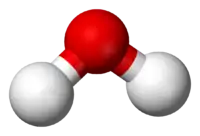Trisilane
Trisilane is the silane with the formula H2Si(SiH3)2. A liquid at standard temperature and pressure, it is a silicon analogue of propane. The contrast with propane however trisilane ignites spontaneously in air.[1]
| |||
| Names | |||
|---|---|---|---|
| IUPAC name
Trisilane | |||
| Identifiers | |||
3D model (JSmol) |
|||
| ChemSpider | |||
| ECHA InfoCard | 100.132.113 | ||
| UNII | |||
| UN number | 3194 | ||
CompTox Dashboard (EPA) |
|||
| |||
| |||
| Properties | |||
| H8Si3 | |||
| Molar mass | 92.319 g·mol−1 | ||
| Appearance | Colourless liquid | ||
| Odor | Unpleasant | ||
| Density | 0.743 g cm−3 | ||
| Melting point | −117 °C (−179 °F; 156 K) | ||
| Boiling point | 53 °C (127 °F; 326 K) | ||
| Vapor pressure | 12.7 kPa | ||
| Hazards | |||
| Main hazards | Pyrophoric | ||
| S-phrases (outdated) | S3 | ||
| Flash point | < −40 °C (−40 °F; 233 K) | ||
| < 50 °C (122 °F; 323 K) | |||
| Related compounds | |||
Related hydrosilicons |
Disilane Disilyne Silane Silylene | ||
Related compounds |
Propane | ||
Except where otherwise noted, data are given for materials in their standard state (at 25 °C [77 °F], 100 kPa). | |||
| Infobox references | |||
Synthesis
Trisilane was characterized by Alfred Stock having prepared it by the reaction of hydrochloric acid and magnesium silicide.[2][3] This reaction had been explored as early as 1857 by Friedrich Woehler and Heinrich Buff, and further investigated by Henri Moissan and Samuel Smiles in 1902.[1]
Decomposition
The key property of trisilane is its thermal lability. It degrades to silicon films and SiH4 according to this idealized equation:
- Si3H8 → Si + 2 SiH4
In terms of mechanism, this decomposition proceeds by a 1,2 hydrogen shift that produces disilanes, normal and isotetrasilanes, and normal and isopentasilanes.[4]
Because it readily decomposes to leave films of Si, trisilane has been explored a means to apply thin layers of silicon for semiconductors and similar applications.[5] Similarly, thermolysis of trisilane gives silicon nanowires.[6]
References
- P. W. Schenk (1963). "Silanes". In G. Brauer (ed.). Handbook of Preparative Inorganic Chemistry, 2nd Ed. 1. NY, NY: Academic Press. p. 680.
- Stock, Alfred; Somieski, Carl (1916). "Siliciumwasserstoffe. I. Die aus Magnesiumsilicid und Säuren entstehenden Siliciumwasserstoffe". Berichte der Deutschen Chemischen Gesellschaft. 49: 111–157. doi:10.1002/cber.19160490114.
- Stock, Alfred; Stiebeler, Paul; Zeidler, Friedrich (1923). "Siliciumwasserstoffe, XVI.: Die höheren Siliciumhydride". Berichte der Deutschen Chemischen Gesellschaft (A and B Series). 56 (7): 1695–1705. doi:10.1002/cber.19230560735.
- Vanderwielen, A. J.; Ring, M. A.; O'Neal, H. E. (1975). "Kinetics of the thermal decomposition of methyldisilane and trisilane". Journal of the American Chemical Society. 97 (5): 993–998. doi:10.1021/ja00838a008.
- United States Patent Application Publication. Pub No. US 2012/0252190 A1, OCT, 4, 2012. Zehavi et al.
- Heitsch, Andrew T.; Fanfair, Dayne D.; Tuan, Hsing-Yu; Korgel, Brian A. (2008). "Solution−Liquid−Solid (SLS) Growth of Silicon Nanowires". Journal of the American Chemical Society. 130 (16): 5436–5437. doi:10.1021/ja8011353. PMID 18373344.








